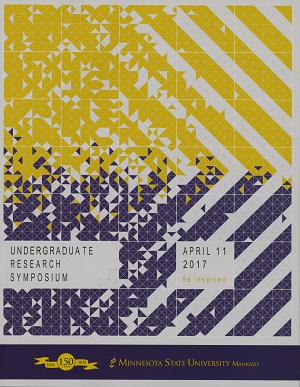Effects of STEAM Play at a Children's Museum
Location
CSU Ballroom
Start Date
11-4-2017 2:00 PM
End Date
11-4-2017 3:30 PM
Student's Major
Family Consumer Science
Student's College
Allied Health and Nursing
Mentor's Name
Heather Von Bank
Mentor's Department
Family Consumer Science
Mentor's College
Allied Health and Nursing
Description
STEAM education (science, technology, engineering, arts and math) is a relatively new concept developed in part from STEM programs by adding art to the curriculum. Recent studies have shown that art and science work together in close proximity. This new paradigm of teaching allows for artistic and creatively charged learning. However, due to the test-oriented constraints of the United States educational system, STEAM is not implemented in most curriculum. Exploring research in this area will provide a holistic learning experience for the participants engaged in the activity.
Student research assistants observed children and families during “STEAM Saturday” programming events. Research assistants completed an observational checklist for each child-caregiver dyad that attended the activity as well as recording types of words that children and adults used by marking the frequency in which participants demonstrated different skills (i.e. problem solving, design, observation). Findings indicate that children and families discussed components of STEAM based activities in diverse ways. Future studies will explore if families talk about STEAM concepts differently depending on the activity. Results gathered from this research project will be available to the staff at the children's museum for grant funding of STEM and STEAM based learning activities. Through this work, we can offer new STEAM activities to the museums' schedule of programs and foster museum staff development that will subsequently benefit the children and families of our community.
Effects of STEAM Play at a Children's Museum
CSU Ballroom
STEAM education (science, technology, engineering, arts and math) is a relatively new concept developed in part from STEM programs by adding art to the curriculum. Recent studies have shown that art and science work together in close proximity. This new paradigm of teaching allows for artistic and creatively charged learning. However, due to the test-oriented constraints of the United States educational system, STEAM is not implemented in most curriculum. Exploring research in this area will provide a holistic learning experience for the participants engaged in the activity.
Student research assistants observed children and families during “STEAM Saturday” programming events. Research assistants completed an observational checklist for each child-caregiver dyad that attended the activity as well as recording types of words that children and adults used by marking the frequency in which participants demonstrated different skills (i.e. problem solving, design, observation). Findings indicate that children and families discussed components of STEAM based activities in diverse ways. Future studies will explore if families talk about STEAM concepts differently depending on the activity. Results gathered from this research project will be available to the staff at the children's museum for grant funding of STEM and STEAM based learning activities. Through this work, we can offer new STEAM activities to the museums' schedule of programs and foster museum staff development that will subsequently benefit the children and families of our community.
Recommended Citation
Dobbins, Ellen; Correy Steffen; and Ella Silver. "Effects of STEAM Play at a Children's Museum." Undergraduate Research Symposium, Mankato, MN, April 11, 2017.
https://cornerstone.lib.mnsu.edu/urs/2017/poster-session-B/21



